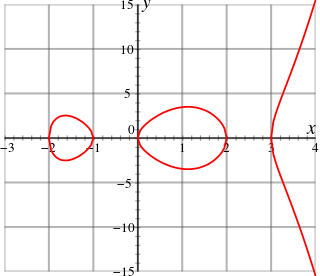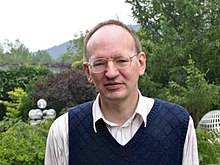In mathematics, the arithmetic of abelian varieties is the study of the number theory of an abelian variety, or a family of abelian varieties. It goes back to the studies of Pierre de Fermat on what are now recognized as elliptic curves; and has become a very substantial area of arithmetic geometry both in terms of results and conjectures. Most of these can be posed for an abelian variety A over a number field K; or more generally.
In mathematics, Diophantine geometry is the study of Diophantine equations by means of powerful methods in algebraic geometry. By the 20th century it became clear for some mathematicians that methods of algebraic geometry are ideal tools to study these equations. Diophantine geometry is part of the broader field of arithmetic geometry.
In mathematics, Roth's theorem or Thue–Siegel–Roth theorem is a fundamental result in diophantine approximation to algebraic numbers. It is of a qualitative type, stating that algebraic numbers cannot have many rational number approximations that are 'very good'. Over half a century, the meaning of very good here was refined by a number of mathematicians, starting with Joseph Liouville in 1844 and continuing with work of Axel Thue, Carl Ludwig Siegel, Freeman Dyson, and Klaus Roth.

Gerd Faltings is a German mathematician known for his work in arithmetic geometry.
In arithmetic geometry, the Selmer group, named in honor of the work of Ernst Sejersted Selmer by John William Scott Cassels, is a group constructed from an isogeny of abelian varieties.

In mathematics, arithmetic geometry is roughly the application of techniques from algebraic geometry to problems in number theory. Arithmetic geometry is centered around Diophantine geometry, the study of rational points of algebraic varieties.
In number theory and algebraic geometry, a rational point of an algebraic variety is a point whose coordinates belong to a given field. If the field is not mentioned, the field of rational numbers is generally understood. If the field is the field of real numbers, a rational point is more commonly called a real point.
In mathematics, a Tate module of an abelian group, named for John Tate, is a module constructed from an abelian group A. Often, this construction is made in the following situation: G is a commutative group scheme over a field K, Ks is the separable closure of K, and A = G(Ks). In this case, the Tate module of A is equipped with an action of the absolute Galois group of K, and it is referred to as the Tate module of G.

In number theory and algebraic geometry, the Tate conjecture is a 1963 conjecture of John Tate that would describe the algebraic cycles on a variety in terms of a more computable invariant, the Galois representation on étale cohomology. The conjecture is a central problem in the theory of algebraic cycles. It can be considered an arithmetic analog of the Hodge conjecture.
This is a glossary of arithmetic and diophantine geometry in mathematics, areas growing out of the traditional study of Diophantine equations to encompass large parts of number theory and algebraic geometry. Much of the theory is in the form of proposed conjectures, which can be related at various levels of generality.
A height function is a function that quantifies the complexity of mathematical objects. In Diophantine geometry, height functions quantify the size of solutions to Diophantine equations and are typically functions from a set of points on algebraic varieties to the real numbers.
In arithmetic geometry, the Bombieri–Lang conjecture is an unsolved problem conjectured by Enrico Bombieri and Serge Lang about the Zariski density of the set of rational points of an algebraic variety of general type.
In mathematics, Arakelov theory is an approach to Diophantine geometry, named for Suren Arakelov. It is used to study Diophantine equations in higher dimensions.
Arithmetic dynamics is a field that amalgamates two areas of mathematics, dynamical systems and number theory. Part of the inspiration comes from complex dynamics, the study of the iteration of self-maps of the complex plane or other complex algebraic varieties. Arithmetic dynamics is the study of the number-theoretic properties of integer, rational, p-adic, or algebraic points under repeated application of a polynomial or rational function. A fundamental goal is to describe arithmetic properties in terms of underlying geometric structures.
In mathematics, the Mordell–Weil theorem states that for an abelian variety over a number field , the group of K-rational points of is a finitely-generated abelian group, called the Mordell–Weil group. The case with an elliptic curve and the field of rational numbers is Mordell's theorem, answering a question apparently posed by Henri Poincaré around 1901; it was proved by Louis Mordell in 1922. It is a foundational theorem of Diophantine geometry and the arithmetic of abelian varieties.
In arithmetic geometry, the Tate–Shafarevich groupШ(A/K) of an abelian variety A (or more generally a group scheme) defined over a number field K consists of the elements of the Weil–Châtelet group , where is the absolute Galois group of K, that become trivial in all of the completions of K (i.e., the real and complex completions as well as the p-adic fields obtained from K by completing with respect to all its Archimedean and non Archimedean valuations v). Thus, in terms of Galois cohomology, Ш(A/K) can be defined as
In mathematics, Vojta's conjecture is a conjecture introduced by Paul Vojta about heights of points on algebraic varieties over number fields. The conjecture was motivated by an analogy between diophantine approximation and Nevanlinna theory in complex analysis. It implies many other conjectures in Diophantine approximation, Diophantine equations, arithmetic geometry, and mathematical logic.

Aleksei Nikolaevich Parshin was a Russian mathematician, specializing in arithmetic geometry. He is most well-known for his role in the proof of the Mordell conjecture.

In mathematics, a Siegel modular variety or Siegel moduli space is an algebraic variety that parametrizes certain types of abelian varieties of a fixed dimension. More precisely, Siegel modular varieties are the moduli spaces of principally polarized abelian varieties of a fixed dimension. They are named after Carl Ludwig Siegel, the 20th-century German number theorist who introduced the varieties in 1943.
In mathematics, the Zilber–Pink conjecture is a far-reaching generalisation of many famous Diophantine conjectures and statements, such as André–Oort, Manin–Mumford, and Mordell–Lang. For algebraic tori and semiabelian varieties it was proposed by Boris Zilber and independently by Enrico Bombieri, David Masser, Umberto Zannier in the early 2000's. For semiabelian varieties the conjecture implies the Mordell–Lang and Manin–Mumford conjectures. Richard Pink proposed (again independently) a more general conjecture for Shimura varieties which also implies the André–Oort conjecture. In the case of algebraic tori, Zilber called it the Conjecture on Intersection with Tori (CIT). The general version is now known as the Zilber–Pink conjecture. It states roughly that atypical or unlikely intersections of an algebraic variety with certain special varieties are accounted for by finitely many special varieties.





















